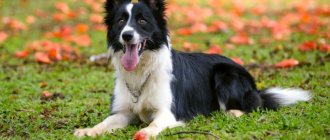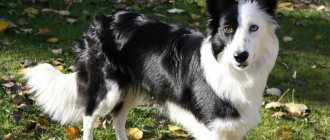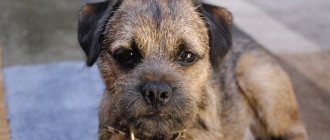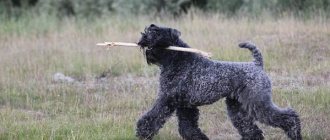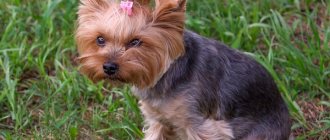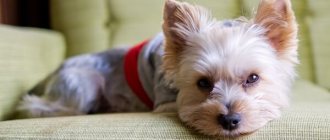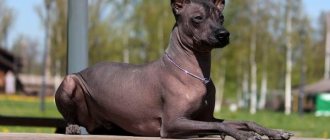Breed characteristics
| Short description | |
| Origin: | Great Britain |
| Conditions of detention: | Apartment |
| Purpose: | Hunting, companion |
| Color: | Red, wheaten, blue and tan, grizzly and tan (dark grey) |
| Wool length: | Short |
| Adult dog size: | The height at the withers is not described by the rules, on average it is 28-35 cm; weight of males – 5.9-7.1 kg, females – 5.1-6.4 kg |
| Average life expectancy: | 13-15 years old |
| Walk: | 2 to 3 times a day |
| Physical activity needs: | High |
| Fédération Cynologique Internationale (FIC) classification: | Group No. 3 Terriers Section No. 1 Large and medium-sized terriers |
| Puppy price: | 20,000-60,000 rub.
|
Pros and cons of the breed
The Border Terrier, despite its friendly disposition, is not suitable for all people. This dog is full of energetic energy, so its owner must also lead an active lifestyle.
The main advantages of the Border Terrier:
1. Friendliness, loyalty. 2. Intelligence and intelligence. 3. Loves children. 4. Suitable for apartment maintenance. 5. Gets along well with other dogs. 6. Not expensive to maintain.
History of the origin of the species
The first mentions of borders date back to the 19th century. Dogs of this type were described in the book “Dogs of the British Isles”, and were also presented in a painting depicting a hunt with a pack. The first animals of this species appeared on the border of Scotland and England, in the Northumberland region. This is what gave the breed its name, because border in English is border (border). The name was officially assigned to the dogs in 1880.
They were used to hunt badgers, foxes, rodents and otters. The animals had to keep up with the horses and hounds. The goal of breeding was to create dogs resistant to any weather, cold and wind.
For a long time, the owners did not want to register the new species with the English Kennel Union, as they believed that this would spoil the working qualities of their pets. It was not until 1920 that Border Terriers were recognized, and at the same time a British fan club for the breed was created.
Description
The Border Terrier is a wire-haired breed of dog, small in size, with a narrow body and long legs. Males at the withers reach 33-41 cm and weigh 6-7 kg, females 28-36 cm and weigh 5-6.5 kg. The coat color can be red, wheaten, pepper and salt, reddish blue or gray.
There may be a white spot on the chest; a dark mask on the muzzle is acceptable and even desirable. The wool is double, the outer shirt is hard, straight, and lies close to the body. The undercoat is short and dense.
The head is medium in size, with a wide, flat skull. The stop is wide, smooth, the muzzle is short. The teeth are strong, white and fairly large for a dog of this size. Scissor bite.
The eyes are dark in color, medium in size, the expression of the eyes is intelligent and attentive. The ears are small and V-shaped. The tail is short and thick at the base, set high.
Distinctive features
All dogs of this species, according to the standard adopted by the FCI (FCI) of 1998, must meet the following parameters:
- The skull is of medium width, with a shortened muzzle that is similar in appearance to the head of an otter.
- Bite - scissors, let's say straight. Overshot or undershot is a serious fault.
- The nose is black (let's say liver or flesh tone).
- The eyes are dark and lively.
- Neck of moderate length.
- The ears are small in size, of medium thickness, hanging down on the sides of the head, fitting well to the cheekbones, reminiscent of the English letter “V”, always directed forward.
- The tail is carried high and usually carried high, but not carried over the back. The length is moderately short, the thickness is well defined at the base, tapering slightly towards the tip.
- The body is elongated, narrow, deep, muscular. The ribs are well stretched back, but slightly curved.
- The legs are muscular, strong, straight, long enough, but the bones do not look heavy. Movements are easy. The paws are small, with thick pads.
- Two layers of wool The undercoat is very dense, similar to felt. The top hair is moderately short, thick and coarse. There is a small “beard” and “eyebrows”.
Scottish Terrier (Scottish Terrier)
The Scottish Terrier has perhaps one of the most famous canine silhouettes. With their long nose, full skirt and prominent beard, they are famous all over the world.
Be prepared to put in the work when it comes to training Scotty. They can be very strong-willed, independent and tenacious. They will react poorly to your attempts to force them to do something they don't want to do.
If you are patient, keep sessions short so your Scottie doesn't get bored, and use positive reinforcement training techniques, you may be surprised at how quickly they catch on. This breed is intelligent; They just often do things their own way!
Scotties tend to be unfailingly loyal to their family and form strong bonds, but that doesn't mean they're lapdogs. They tend to be free spirits and usually seek attention on their own terms.
If you keep your Scottish Terrier's coat in a longer, full-skirted style, you will need to maintain a more regular grooming regimen to prevent knots or tangles from forming. They also need to be trimmed or brushed by hand periodically, as the coat grows constantly and relatively quickly.
Photo of an adult dog
Pedigree standards
- Small flat head.
- The muzzle is decorated with a neat beard.
- Dense row of teeth with a scissor bite.
- Black nose with dark brown nose.
- Almond-shaped eyes of dark brown shades.
- Small, triangular-shaped ears droop.
- Strong physique.
- Proportional neck, slightly elongated.
- The chest is not very deep.
- Extended legs.
- High tail. Strong and thick, tapered at the end.
Photos of puppies
Catsbri
Roxanne_Bryan | Editor-in-Chief | Email
While men everywhere are breeding their breeds for "No Shave November", these dog breeds have them running out with fashionable beards 365 days a year.
This adorable breed looks like an Ewok on four legs, with a personality to match. While their beards may not be as full as some other breeds, they certainly complement their faces well.
This handsome terrier has a beautiful clean face, with a large old beard that makes him look like a professor from the 18th century. All he needs is a monocle, don't you agree?
With such a name, the beard had to be included in this list. He has a nice long goatee that matches the rest of his coat. He's kind of the dog version of Cousin It.
Luigi Guidobono Cavalcini
This naturally crowned dog breed has a beautiful, neat beard that nicely offsets the rest of his appearance. This tends to get a little messy, as the breed standard is to only bathe them a few times a year.
Features of character and behavior
The Border Terrier is an active and obedient animal if its energy is given the right outlet. For a family with teenage children, he will be an ideal companion.
Advantages
- The Border is a fairly balanced dog, at the same time very attached to the owner and obedient, which makes him an excellent pet.
- He always tries to be unobtrusively present next to the owner or members of his family.
- He will be happy to play and run with children, as he is naturally active and energetic.
- His hunting background makes him susceptible to training and obedience to the owner, the dog will try to please him. Since they were usually used to chase animals in a pack of several individuals, Borders became one of the most tolerant of other people's dogs, if we consider the terrier family. They themselves will not provoke fights on the street.
- This is a brave and courageous dog, although it is not a guard, it will always try to drive away an intruder from its owner by barking. At the same time, in a calm environment, the dog rarely uses his loud voice.
Flaws
Dogs are very attached to the company of people, therefore, with a lack of attention, or if they are constantly alone, terriers can show all the destructive traits of their personality . The same situation will arise with a lack of physical and mental stress.
Dogs of this breed love to chew things, jump into places where they are not allowed, and also dig holes in any surface, be it the ground or a mattress. It is advisable to buy them various toys and bones that will distract them from destructive actions and wean them from harmful tendencies from childhood.
A love of digging and jumping can encourage a pet to escape if the area of the house or playground has problems with fencing. Although this is one of the most peaceful terriers towards its relatives, representatives of the breed do not really like dogs of the same sex, especially if they show aggression. The borderer himself will not start the conflict, but will always respond.
In addition, the hunting background imposes a ban on keeping small animals in the same apartment with a representative of the breed - hamsters, rats, ferrets, and so on. They get along with cats in different ways; some terriers treat them well, especially if they have lived together since childhood, but dogs most often perceive street and neighborhood pets as potential prey.
Despite the fact that, in principle, dogs love to play with children, they will not tolerate careless handling and intrusiveness, so it is undesirable to leave dogs alone with children.
Possible diseases and methods of treating them
It is interesting that this breed was created with virtually no human intervention, so it can easily be called “natural.” Hence the excellent health of its representatives. However, they can also get sick, such as a cold.
How can you tell if your dog is sick? The main sign of illness in animals is refusal to eat. If your pet is suddenly losing weight and eating little, take him to the vet immediately. Only he will give him an accurate diagnosis and prescribe treatment.
In addition to colds, Border Terriers are faced with cataracts, dysplasia and allergies. All these diseases cannot be called breed-specific; many dogs of different species experience them. They should be treated by a specialist.
But you can treat your dog for parasites, especially worms and fleas, yourself. It is better to do this annually so that the animal’s quality of life always remains high. You can buy deworming tablets and flea spray for him. It is recommended to use medications after thoroughly reading the instructions attached to them.
Care and maintenance
The Border Terrier's coat does not require special care. Due to its structure, the cover is almost impervious to water and dirt, dogs feel great in rain and cold. The breed is healthy, but some diseases may occur.
It is better to keep borders in an apartment, possibly a private house with a backyard for walking.
The claws are trimmed a couple of times a month, the ears are inspected daily, especially in the summer, keeping an eye out for mites and inflammation. Eyes are washed if necessary, teeth are cleaned weekly.
Nutrition
Representatives of the breed love to eat and can gain excess weight. In addition, food allergies are common in dogs. Therefore, you should strictly measure the volume of portions, control the calorie intake, and minimize treats. It is advisable to limit the consumption of cereals, potatoes, and bread . It is better to introduce all new products gradually and in small quantities, carefully monitoring the pet’s condition.
You can feed Border Terriers both natural food and professional food. You should not mix both types of nutrition, as this will lead to gastrointestinal and liver diseases. It is better to buy premium or super-premium brands, they contain natural ingredients and vitamins.
You should choose food that is high in protein, as this is an active breed. Brands with hypoallergenic composition are also recommended.
The basis of a natural diet should be lean meat and offal. Boiled sea fish, without bones, may be present. It must be remembered that it can become a source of allergies.
The menu may contain:
- Porridge;
- Bouillon;
- Vegetables;
- Fermented milk products;
- It is recommended to give your dog boiled eggs 1-2 times a week (if the product is well tolerated);
- Cottage cheese.
Bones, especially tubular ones, are completely prohibited, as are fatty, fried, spicy, and sweet foods from the table.
The number of meals depends on the age and condition of the pet, you can focus on the following intervals:
| Age, months | How often to feed, once/day |
| 1-2 | 6-7 |
| 2-4 | 5 |
| 4-6 | 4 |
| 6-10 | 3 |
| from 10 | 2 |
We recommend that you read a detailed article on the topic: “How and what to feed a dog: types and characteristics of nutrition.”
Health
The breed is quite healthy, but has a predisposition to certain diseases.
Vaccinations
Terriers are vaccinated with a complex vaccine that works against several diseases at once. A week before the procedure, the dog must be treated for helminths. Adult dogs are vaccinated once a year , children - twice (the timing of vaccination for puppies differs depending on the drug, but usually it is 8 and 12 weeks).
After the procedure, little border dogs are subject to a 2-week quarantine, during which their health needs to be monitored and walking is prohibited.
Vaccination minimizes the risk of the following diseases:
- rabies;
- coronavirus;
- parovirus enteritis;
- plague;
- parainfluenza;
- hepatitis;
- leptospirosis;
- trichophytosis.
Important article on the topic: “Everything you need to know about dog vaccinations.”
Diseases
Terriers are prone to certain diseases. Among them:
- Dysplasia of the hip or elbow joint. The disease is congenital, manifesting itself after 15 months. in the form of stiffness of movement, pain, and can lead to immobility.
- Cataract. Impaired transparency of the lens, leading to decreased vision. The surface of the eye is cloudy, bluish-gray.
- Epilepsy, Spike's disease. Manifests itself in the form of convulsive seizures against the background of congenital disorders of brain functioning.
- Spongiform leukoencephalomyelopathy. It manifests itself in puppies with severe trembling when moving. Most babies are subject to euthanasia due to impaired quality of life.
- Puppy ataxia is genetic. A practically incurable disease, it manifests itself in uncoordinated and unsteady movements, falls, and ocular nystagmus. Leads to complete immobilization and inability to eat.
- Retinal atrophy. A genetic problem leading to almost complete loss of vision receptors and blindness.
- Cryptorchidism. A congenital anomaly in which one or both testicles in a male do not descend to their proper place.
Also, pets often experience obesity and allergic manifestations.
Walk
Border Terriers require active walking for at least 2 hours a day. They don't like to lie on the couch; they need to run, jump, and swim. Considering their abilities, we can recommend participation in agility, coursing and other dog competitions. They will also be happy to run after the Frisbee disc and ball.
Dogs have previously accompanied riders on horseback while hunting, so they will enjoy running behind their owner on roller skates or a bicycle at a not very high speed.
Dogs are prone to running away, especially if they notice “prey”, so it is better to keep them on a long leash. Free walking is possible only if the command “Come to me” is absolutely followed, as well as in the absence of conflicting dogs nearby.
You should not walk your pet near neighbors' flower beds or in parks, as the dog can dig up everything.
Grooming
The Border Terrier's coat is easy to care for. It is enough to comb it once a week. Shedding is weakly expressed, since in order to remove dead hair it is necessary to trim the animal. The procedure is carried out 2-3 times a year , avoiding winter time. To determine whether your pet needs trimming, you need to pull a small tuft of fur towards you. If it is easily pulled out, then the hair has already died off; healthy hair cannot be removed in this way.
For show animals, trimming and grooming requires more attention and the use of special tools. The main steps are as follows:
- Ears. Should look smooth, hair should be plucked from the entire surface. The contour is processed with scissors, the area of the ear canal is cleared of hair with tweezers.
- Beard. Dead fur is plucked out. They follow the contour with scissors, slightly rounding it.
- Back. All dead hair is removed straight and evenly.
- Frame. All protruding or too long hairs are removed, the rest is combed.
- Neck. The hair is plucked and removed in such a way that a smooth transition is formed, without “dips” and “hills” at the withers.
- Lower chest area. Here a smooth flow is formed to the abdominal line using trimming tools or scissors.
- Front chest. An “arc” is formed and all long and protruding hair is removed.
- Belly line. Smoothed using tools.
- Hips. The internal zone is processed with thinning scissors. The outer part and “pants” are cleaned of protruding hair. The outer area should look completely smooth.
- Front legs. The back of the limbs is plucked short; no long hairs should remain on the elbows.
- Paws. The wool is cut in a circle with scissors. It is necessary to form a contour so that the claws become visible, to make the limb look like a cat's paw.
- Tail. Long hairs are removed from the upper and lower zones. The contour is given the shape of a “carrot”, slightly narrowing it towards the tip, which is rounded.
Dogs are bathed rarely enough so as not to wash off the protective layer from the surface of the coat. The rest of the time, it is enough to wipe the contaminated areas with a damp cloth or rinse with water without shampoo and soap. It is permissible to use a furminator, but in limited quantities.
Nutrition
This dog eats almost everything; he is not picky about food. He can eat dry food, canned fish, stewed meat, cabbage roll, borscht, pasta, etc. He can’t eat everything from this list. Unfortunately, due to poor nutrition, pet dogs often become ill and die prematurely.
If we talk specifically about a representative of this breed, we cannot fail to note his small stomach. In one meal, he should digest no more than 200-300 grams of food. If you neglect this rule and give your dog more, the walls of its stomach will stretch, and this will lead to digestive dysfunction.
Therefore, it is better to feed the animal a little, but often. It is advisable to do this systematically and at regular intervals, for example, at 8.00, 12.00, 15.30 and 19.00. This will help your dog’s body function better.
A Border Terrier puppy under 1 year old should consume natural foods: milk, eggs, soups, cottage cheese, fruits and vegetables. You can also give him boiled potatoes, unseasoned pasta, porridge with butter and chicken (boiled or raw).
An animal that is older than 1 year can live normally by eating canned food (can be replaced with dry food). There are all the substances that are useful for him. Also remember to regularly fill his bowl with clean water. The terrier drinks a lot, as he is constantly moving.
Mating
The first mating is carried out no earlier than 1.5 years (for males 1 year), although it is advisable to wait until 2-2.5, which is when the dog reaches full maturity. To select a match for your pet, the owner needs to contact the kennel club or directly to the owner of a suitable candidate.
Parents are selected taking into account that the advantages of one compensate for the disadvantages of the other, and all the positive characteristics are only enhanced in the future offspring.
Both members of the pair must have sufficient show scores for breeding that confirm their suitability for the future goal. Parents must have age-appropriate vaccinations and be treated for helminths. At the first meeting, the female is brought to the male’s territory, mating is repeated 1-2 more times with an interval of about a day.
Read a detailed article on the topic: “Everything you need to know about breeding dogs: appropriate age, what to do if it doesn’t work out, rules and tips.”
Health and life expectancy
The Border Terrier is endowed with good health. But some diseases do not bypass them. This:
- Obesity due to improper feeding;
- Dysplasia of the hip and elbow joints;
- Heart problems;
- Retinal atrophy (progressive);
- Cataract;
- Slow response to anesthesia.
On average, the Border Terrier lives 13-16 years .
Key points in training
Terriers are very smart, love to work and fulfill the wishes of the owner, so they are easy to train. Considering that border babies mature slowly, it is better to use a game strategy when teaching. Training should begin from the moment the pet appears in the house, paying special attention to the commands “Come to me” and “No”.
Like all terriers, Borders are stubborn and try to dominate. Therefore, training must be persistent; the pet should not be allowed to decide whether he will follow the command or not.
Read about how to properly train a dog in the article: “Training a puppy: effective methods from dog handlers, learning commands at home.”
You should not shout or hit the dog if it refuses to complete tasks and is offended by the owner. It is better to use the most interesting and varied tasks that will make the animal think, reinforcing the execution with praise, stroking, and treats.
Terriers can also be used for hunting; the working qualities of the representatives of the breed are not lost. Preparation begins from an early age, and before taking part in the process for the first time, it is necessary to make sure that the animal responds to the owner’s call and is able to withstand the load. It is advisable to provide your pet with an address card and a chip in case of loss.
Training and education
The Border Terrier, with its irrepressible character and amazing energy, requires an appropriate approach to training.
Representatives of the breed are very smart, quick-witted dogs. Border is capable of learning quite a lot of commands in a relatively short time.
If the owner has established contact with the pet, if the pet is well brought up and trained, he understands without words by signs and movements what is required of him.
It is important to be consistent in your training. Training should not be monotonous and boring. But this requires strict adherence to the regime; work with the terrier on a schedule.
Active, varied lessons, partly in a playful form, are the key to successful training. Avoid rudeness and physical punishment. Reward your pet using treats and praise.
If the terrier is to be used for hunting, it must be trained from the age of six months.
Interesting Facts
- The Border Terrier is the smallest of the working terriers. In European countries, borders are considered excellent therapists, capable of uplifting even the most inveterate pessimists. This is why these dogs work in nursing homes and shelters.
- In Sweden, Border Terriers are used to search for people in rubble, in the UK - as assistants for the deaf and mute, in the USA, Border Terriers are an indispensable member of the Search and Rescue team. The team is searching for missing persons.
- Borderers do not suffer from seasickness and love to travel in public transport.
- Borderers are not at all afraid of horses and can walk freely between the hooves of these animals.
- Borderers, being in a great mood, “smile.” They stretch their lips, showing their teeth, resulting in a funny smile.
How to choose a puppy
Before you buy a baby of this breed, you need to contact a nursery with a good reputation or a private breeder . An animal purchased secondhand does not have proof of origin and may grow up to be completely different from the desired exterior.
During your first visit to the breeder, it is advisable to check the pedigree and show scores of the parents. In this case, you can get guarantees that the puppy will grow up to be a Border Terrier and not something else.
Both the mother and father of the baby must be healthy, with completed veterinary passports, vaccination and deworming records. It is advisable to request from the breeder the results of testing for dysplasia, ataxia, and spongiform leukoencephalomyelopathy.
The puppy should not show signs of illness, aggression or cowardice. The breeder issues a veterinary passport for it with the first marks and a metric, which the owner will later exchange for a pedigree.
Borders are good family pets, provided they have an active lifestyle and treat the dog correctly. Caring for him is not difficult, the dog is in good health, and is also focused on human contact - all this allows you to keep the dog in an apartment environment and helps you become an ideal pet.
5 / 5 ( 3 voices)
Price
If you dream of having a loyal friend and a capable, intelligent hunter, then a representative of this breed will be a good choice. We advise you to seek help from competent people who have many years of experience in breeding such dogs. They are available in specialized clubs and nurseries. You can also find reviews from professional breeders of this breed.
In 2022, the minimum price for a high-breed border terrier was 35 thousand rubles. A puppy can be obtained with or without a pedigree. In the first case, you will be able to register it to participate in a competition or exhibition, but in the second case, not.
Dogs with a beard: types and their characteristics, selection and care
join the discussion
Share with your friends
Among all the currently existing varieties of dogs, bearded animals stand apart. For some they cause bewilderment and fear, while others dote on their four-legged pets that have this feature.
What caused dogs to have beards? What other features do such unusual animals have? What dog breeds are bearded? Find answers to these and some other questions in our material.
Price and where to buy a puppy?
Depending on the purpose, the cost of litter varies.
Offspring without the possibility of exhibition or further breeding costs from 10 thousand rubles. If there are plans for future puppies as parents, then the price increases 2-3 times. Show-class puppies cost from 50 thousand rubles.
In Russia, this breed is only gaining popularity.
You need to choose only from those registered in the unified international register of breeders, where there is a guarantee of “pure blood”. In this case, a purchase and sale agreement must be signed, which spells out all the circumstances in order to avoid misunderstandings.
Buying a puppy “hands-on” at a “poultry market” is a huge risk of getting a “mongrel”. While the dog is small, it is difficult to understand how well he meets the requirements. If you purchase, then only from trusted sellers who guarantee the quality of the litter.
Dog kennel Domino's dog. Great Dane, Border Terrier
Description:Contacts:
| Our breeds are the Great Dane of black and merle colors and the Border Terrier. We provide assistance in raising puppies, provide veterinary services and food. |
| 8 |
Dog kennel from Wales. Border Terrier, Welsh Terrier
Description:Contacts:
| Our dogs combine excellent working qualities, true terrier character and conformation. |
| 89175527024 |
Advantages and disadvantages
The breed has good service and working characteristics. Borders are cheerful, active and not too noisy pets. They only bark when they give a hunting signal. Open and good-natured, they get along well with people and willingly spend time with children.
One of the disadvantages is their ineradicable instinct to dig, so that without supervision the pet can dig up the entire area. Borders love to chew on something, so they cannot do without special devices. People with a sedentary lifestyle should not get a Border Terrier , as an active animal will suffer without physical activity. Borders experience severe stress even when their owner is absent for a long time.
Some people think that the Border Terrier is a nondescript dog, and dog handlers are still arguing about the incomplete appearance of the breed. There is still some debate about separating Border Terriers for show into varieties based on size and weight. Some consider the correct size to be the most important aspect of border dog conformation. What do you think?
Border Terrier Personality
All owners are sure of one thing - the character of Border Terriers is soft and flexible. The dog is friendly, always ready to frolic and play with the owner. This baby becomes attached to its owner for life. There are cases where a terrier died during a long separation.
Attention and communication with people is a necessity for the Border Terrier. They need active play every day and, if possible, meetings with other dogs of different breeds. This will make the dog's life truly happy.
Borders were distinguished by their good, stable psyche, courage and endurance unimaginable for a dog of this size. The dog will be friendly with a new person, but will still sniff him without losing his vigilance.
Although the terrier is not very large, he is always ready to protect his family - and especially his owner. He will attack even a larger dog completely fearlessly.
Despite such bravery, in the domestic circle the terrier is absolutely calm and affectionate. He will happily lie next to you while you watch TV, and then play ball or go for a walk. A dog loves all family members, but it has much higher feelings for its owner.
If it's raining outside, that's no reason not to go for a walk! This is the Border Terrier's motto. Its dense, hard coat with a thick undercoat prevents raindrops from reaching its delicate skin. So you will have to walk every day, regardless of the weather. And such an active and cheerful dog needs from 2 to 4 hours of being outside every day.
Do not deny yourself and your pet the desire to play something in the nearest park. Bring a ball or frisbee from home and let your dog get some exercise without a leash.
Border Terriers are often found in nursing homes. They are great at brightening up the time for elderly people, and they are also used as four-legged doctors. In Europe this is especially popular.
Choosing a nickname
The Border Terrier comes from England. It is better to choose resonant, loud nicknames that have something connected with Great Britain. The main task is that the name should be well remembered and perceived by ear.
| For males: | Art, Biffy, Blade, Break, William (Willie), Heinrich, Jarrett, Jerry, Kelvin, Cody, Corey, Nolan, Pikachu, Ralph, Rauf, Remmy, Ricci, Roger, Sally, Studdy, Tobby, Thorne, Fox, Chain , Sheldon, Yunni. |
| For Border Terrier girls: | Irish, Alfreda, Arena, Bonnie, Britta, Bria, Jane, Diana, Keira, Corrie, Lucy, Myla, Megan, Melody, Note, Paris, Sydney, Fiji, Chelsea, Sherrill, Ellie. |
The dog will remember, learn and respond to an easy name faster.
Soft Coated Wheaten Terrier
- Height: from 43 to 48 cm
- Weight: from 14 to 18 kg
- Life expectancy: 12 to 15 years
- Temperament: smart, energetic, affectionate, playful, loyal
Wheaten Terriers are loved for their cheerful nature and soft, wavy coat. These tall and strong terriers were bred to catch barnyard rats.
IMPORTANT! Today's energetic Soft Coated Wheaten Terriers still need an efficient way to burn off energy, but they should not be allowed off leash in open areas as they will chase other animals, cars and even children on bicycles.
These silky beauties need to be brushed regularly to remove dirt from their fur and get rid of tangles. Sounds like too much work? Then consider one of these short-haired, low-maintenance dog breeds.
Brussels Griffon
- Height: from 23 to 28 cm
- Weight: from 4 to 5 kg
- Life expectancy: 12 to 15 years
- Temperament: sensitive, narcissistic, inquisitive, alert, sociable
These sweet, sensitive canines come in two varieties: smooth-coated and coarse-coated. Coarse-coated Brussels Griffons have a thick beard that makes their flat faces look downright comical. Their coat is usually cut short, leaving only a beard, which requires frequent washing.
These intelligent dogs will bond with their people and make loyal, long-living pets. They require a moderate amount of exercise and are well suited to apartment living.
Bearded Collie
- Height: from 51 to 56 cm
- Weight: from 18 to 27 kg
- Life expectancy: 14 to 15 years
- Temperament: intelligent, resilient, self-confident, alert, active
With his boundless energy, a Bearded Collie can easily work his way straight into your heart. Bred as herding dogs, these lovable family pets are famous for their clown-like antics and, of course, their long, flowing coats and bushy beards and mustaches.
Since these medium-sized dog breeds require weekly brushing, which includes brushing, it's best to get them into the habit of brushing their teeth as early as possible, as well as grooming their paws - you'll be washing and cleaning those furry mittens often!
Small dog breeds with beards
In addition to small terriers, abundant hair adorns the muzzle of griffons, lapdogs, and long-haired miniature dogs. There are many such breeds. Here are examples of the most notable small bearded dogs.
Brussels and Belgian Griffons
Both breeds descended from the same ancestor - a small, wire-haired "smoisier" dog, which lived near Brussels for centuries. Therefore, griffons have the same size - no more than 30 cm, build, coat type, and temperament.
The only difference is the color:
The decorative fur begins just below the eyes, frames the bridge of the nose and forms a thick mustache with a beard from one ear to the other. Elongated hairs above the eyes form the eyebrows.
Lhasa apso
These are miniature but strong dogs. Long, heavy hair completely covers the body and head, but does not interfere with vision or hinder movement. A long beard grows on his chin.
It was not by chance that such a coat was formed. The ancestors of Lhasa Apsos lived in the harsh climate of Tibet. A thick fur coat protected from the cold, and hair flowing forward hid his eyes from the wind, bright light and dust. Lhasa Apsos are among the longest-living dogs, often living 20 years or more.
Shih Tzu
The ancestors of the Shih Tzu are the ancient miniature dogs of the Chinese emperors. The maximum height is 27 cm. Outwardly, they are similar to Lhasa Apso, the main distinguishing features are a shortened muzzle and an upturned nose. Among the Shih Tzu there are also many long-livers with an age of 18–20 years.
